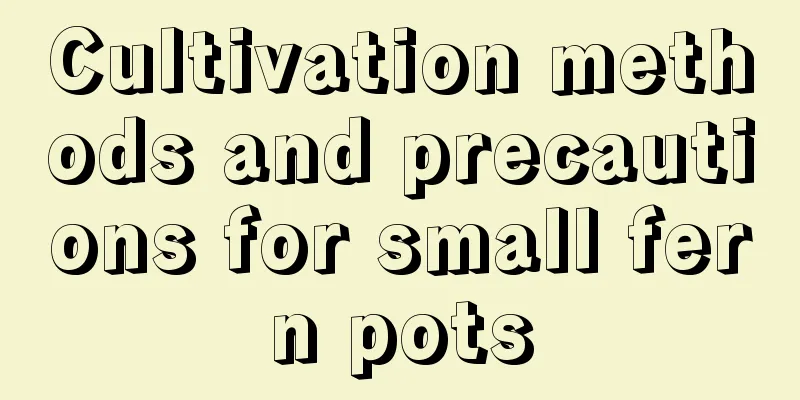Cultivation methods and precautions for small fern pots

1. Maintenance methods1. Soil: It is best to choose soil made from rotten branches and leaves, because its soil contains rich organic matter, which can provide sufficient nutrients for it to grow better. 2. Water: It has a great demand for water and the soil must be kept moist for a long time. However, when the weather is cool, you should control the amount of water appropriately to avoid waterlogging caused by excessive amount. 3. Nutrients: Ferns are fertilizer-loving plants, so fertilizers should be applied to them in time after planting. Generally, organic fertilizer is the best choice. Frequent fertilization can make the leaves thick and green. 4. Light: When planting, it is necessary to provide it with sufficient sunlight, but it is not suitable for strong light exposure, which will sunburn its leaves. Diffused light exposure is best during full sunlight. 2. Breeding techniques1. Pruning: After planting, many small stems and leaves will grow. At this time, some old stems and leaves will dry up or even wilt, so they should be properly pruned and shaped. 2. Reproduction: Propagation by division is a commonly used method. Select healthy plants and be careful when dividing to avoid damaging the branches, stems and roots. Transplant it in soil with sufficient nutrients and then water it and it will survive in about a week. 3. Problem diagnosis and treatment1. Anthracnose: Anthracnose is a common disease of planted ferns. The most harmful thing is the newly grown shoots. You should dilute some chlorothalonil and spray them on them. 2. Root rot: When watering, avoid excessive watering. Long-term waterlogging will cause root rot. Watering to moisten the soil layer can avoid root rot. IV. Other issues1. How to spend the winter: When the weather is cold, move it indoors for maintenance, and the temperature should be controlled above 10℃. If the temperature in the house is too low, it will stop growing and may even freeze to death. 2. Can it be raised indoors: It can be raised indoors, but be sure to place it in a ventilated place and keep the air in the house fresh. Lack of ventilation will affect its growth and may also cause disease. |
<<: Breeding methods and precautions for Qianyu Crane
>>: Coffee tree cultivation methods and precautions
Recommend
There are succulents everywhere in front of and behind the house, so many that they can only be fed to cows!
The Clivias in front of and behind the house look...
How to plant Jade Leaf Golden Flower seeds
Seed treatment Jade Leaf Golden Flower seeds can ...
When is the best time to bag Majiayu
Effect of bagging on pomelo 1. Improve the appear...
Cicada breeding and hatching technology
The golden cicada is a metamorphosed insect, whic...
What fertilizer is suitable for tomatoes?
Tomato fertilization time The main method of fert...
What flowers are suitable for growing in Kunming? What are the city flowers and trees?
1. Climate characteristics of Kunming Kunming is ...
How to grow the peace lily tree to make it flourish
1. Temperature The peace lily is not very cold-re...
The difference between Ixora and Hydrangea
1. Differences in plant types Ixora is a shrub wi...
Where is the best place to place hyacinth hydroponically and how long does it take to bloom?
1. Placement When hyacinth is hydroponically cult...
What causes root rot in Cineraria
1. Caused by too much watering When watering, som...
How to slow down the growth of strawberry seedlings in balcony pots
Seedling treatment It is actually better to proce...
How often should I water the anthurium? Should I water it every day?
How often should you water Anthurium? During the ...
How to care for jade tree to grow fast
Yushu Growing Conditions Jade plant needs suffici...
Is mushroom cultivation profitable? Benefits and profits of cultivation
Is growing mushrooms profitable? Mushroom is a ki...
How to grow star horn quickly
Planting materials: Planting material is the basi...









